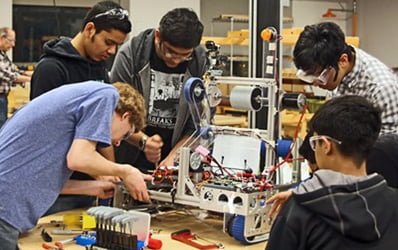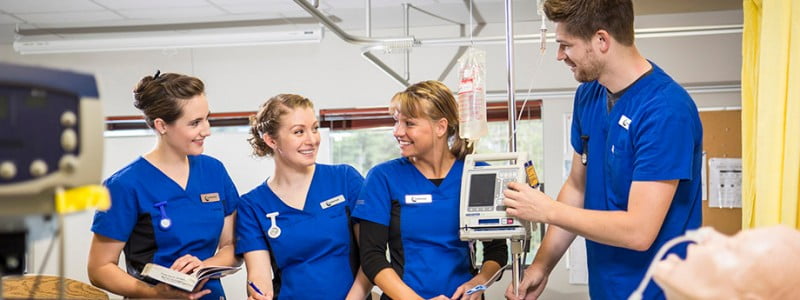Career Tech Education for All
The Next Step in the Evolution of CTE
Career Technical Education (CTE) has evolved to become a valuable, robust, and flexible form of instruction that would be beneficial to all students, not just those enrolled in technical or vocational schools.
This is the next step in the evolution of CTE.
CTE education has become more popular to the general student population. Unlike previous generations, many current graduates of career tech high schools are going on to attend college, and study subjects such as engineering, biotech, and information technology. This trend should be encouraged.
The positive aspect of this evolution for the entire population is that it aligns with many relevant trends in 21st century education. Many of the goals identified in current education plans for traditional academic high schools are already being implemented in Career Technical Schools:
21st Century Skills
Educators and employers recognize that students need to acquire specific skills to succeed in the 21st century: creativity, collaboration, critical thinking, and communication. Because of the way their curriculum is designed, CTE schools have already responded to these new needs. Through their advisory committees, CTE curriculum has paralleled the economy’s shift from manufacturing to service to sharing. Along with this evolution, they have introduced these 21st century skills into day-to-day coursework. Students often work in teams to collaborate on projects; are challenged to create solutions to real world problems, communicate their results to the class, and critically research precedents. CTE graduation requirements often include innovation or entrepreneurship courses.
Project-based Learning
It has long been recognized that students have multiple intelligences. Some learn better with lecture style learning, some prefer reading for themselves, or watching a video. Many learn best by actually doing- designing and physically creating things with their own hands. This is the basis for project-based learning that is at the core of Career Tech Education. For example, for some students in a purely academic setting studying calculus might be a vague abstract concept. But in a career tech school setting, a student plotting the motion of a robotic arm retains a great deal more of the concepts. This type of learning makes the subject relevant and more real world.
 Integrated Curriculum
Integrated Curriculum
Many schools encourage cross-curricular collaboration; CTE schools have been doing this years. As part of each career area, students spend time in both the traditional “shop”, as well as in an adjacent “Theory” classroom. This is where a carpentry student learns about geometry, an auto mechanic appreciates physics, or a health tech student understands biology.
Lifelong Learning
There is an emphasis on lifelong learning in school today, based on the recognition that future workers will need to adapt their skills over time to new, and currently unknown jobs. Students must learn how to learn. This skill is being encouraged in Career Tech education by exposing students to both current career needs and by sampling other fields through required “exploratory” programs.
CTE also partners with business and industry in a region to stay forward-looking. Business leaders serve on the school’s advisory committees to provide relevant input on curriculum. They also provide internship opportunities for students to get real world experience while still in high school. This partnership creates valuable community involvement for schools and richer experiences for students.
Block Scheduling
Many educational consultants recognize the value of longer class periods, or “block” scheduling that allows for more innovation such as project -based learning, in-depth science labs, and cross-curricular opportunities. For such experiences, 50 minutes periods just won’t do. CTE schools have extreme block scheduling- rather than a typical school schedule; CTE students have alternating weeks with an entire day devoted to their career area. This provides tremendous flexibility for the instructors to utilize a variety of teaching methodologies including activities, projects, and field trips.
Personalized Learning
Another important development in education has been the recognition of the value of personalized learning. Not only does this recognition allow a student to flourish by utilizing their predominant learning style, it also strengthens the student-teacher relationship. This provides each student with an adult role model who knows that individual and takes an interest in her development. CTE education has developed this model for some time now- with both low teacher student ratios (often 1 to 12) and longer contact time (entire weeks together).
So how could the richness of CTE be applied to traditional academic high schools?
1) More Comprehensive High Schools These are schools that offer both general academic courses and career tech education. There would need to be scheduling flexibility to operate on two different schedules under one roof, but having the CTE resources available opens opportunities for all students to experience at least some career technical education. It also provides traditional academic courses with more cross-curricular opportunities.
2) Regional Career Tech Centers For those who can’t afford to have certain CTE programs within their district, or that don’t have enough students to justify a CTE program, a regional career tech center may be the most appropriate solution. Such schools are shared resources, usually funded by the state or county. Students are typically bussed there from their home high school for half-day CTE courses. A secondary use of such facilities could be to support Community College degree programs and adult job-training.
3) Offer a General Integrated Curriculum with long-block scheduling, cross-discipline curriculum, and project based learning. Without the typical CTE shop spaces, such a school would need to add (or reconfigure) spaces for such activities as collaboration/ break- out areas, project rooms, maker spaces, and learning commons. This would bring the CTE approach to the traditional academic population by providing students with more and different ways to learn.
Four recommendations to make this happen:
1) At the Local Level – School systems could make the commitment to re-examine their educational methodologies to encourage CTE into their curriculum. Exposure to some CTE courses could be a requirement for graduation.
2) At the State Level – the State is best positioned to identify the local and regional economics as to what skills and career education is needed. In Massachusetts, the MSBA could fund more CTE projects, and support more comprehensive high schools. The State Department of Education could investigate the feasibility of regional CTE centers.
3) At the Federal Level – Currently the federal Carl D. Perkins Vocational and Technical Education Act funds the purchase of vocational equipment exclusively for CTE schools. This funding could be more widespread to support traditional academic high schools as well if they demonstrate that they integrated CTE into their curriculum.
4) At the Private Level, Independent schools could encourage the notion of college credit for certain CTE type high school courses. This would make the school more affordable and improve the perception of career education in general.
Career Technical Education continues to evolve. It now provides programs and pedagogies that complement and enhance academic preparation for all. With continued focus and emphasis, CTE can be the model for true 21st education.

See Carl’s other CTE article, The Evolution of Career and Technical Education.

